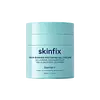What's inside
What's inside
 Key Ingredients
Key Ingredients

No key ingredients
 Benefits
Benefits

 Concerns
Concerns

No concerns
 Ingredients Side-by-side
Ingredients Side-by-side

Water
Skin ConditioningSqualane
EmollientPropanediol
SolventJojoba Oil/Macadamia Seed Oil Esters
Skin ConditioningTriheptanoin
Skin ConditioningNiacinamide
SmoothingSaccharide Isomerate
HumectantAmmonium Acryloyldimethyltaurate/Vp Copolymer
Squalene
EmollientZinc PCA
HumectantHydrolyzed Hyaluronic Acid
HumectantGlycerin
HumectantCamellia Sinensis Seed Extract
HumectantAllantoin
Skin ConditioningPhytosteryl Macadamiate
Skin ConditioningPhytosterols
Skin ConditioningAcetyl Glutamine
Skin ConditioningLecithin
EmollientCaprylyl Glycol
EmollientAmylopectin
Sodium Hyaluronate
HumectantFolic Acid
Skin ConditioningOligopeptide-3
Skin ConditioningBacillus/Soybean Ferment Extract
Skin ConditioningOligopeptide-1
Skin ConditioningOligopeptide-2
Skin ConditioningHexapeptide-11
Skin ConditioningTocopherol
AntioxidantLithothamnion Calcareum Extract
Skin ConditioningLactic Acid
BufferingGlucose
HumectantAcetyl Heptapeptide-4
HumectantC14-22 Alcohols
Emulsion StabilisingC12-20 Alkyl Glucoside
EmulsifyingEthylhexylglycerin
Skin ConditioningTrisodium Ethylenediamine Disuccinate
Potassium Sorbate
PreservativeCitric Acid
BufferingSodium Citrate
BufferingPentylene Glycol
Skin ConditioningSodium Benzoate
MaskingXanthan Gum
EmulsifyingPhenoxyethanol
PreservativeWater, Squalane, Propanediol, Jojoba Oil/Macadamia Seed Oil Esters, Triheptanoin, Niacinamide, Saccharide Isomerate, Ammonium Acryloyldimethyltaurate/Vp Copolymer, Squalene, Zinc PCA, Hydrolyzed Hyaluronic Acid, Glycerin, Camellia Sinensis Seed Extract, Allantoin, Phytosteryl Macadamiate, Phytosterols, Acetyl Glutamine, Lecithin, Caprylyl Glycol, Amylopectin, Sodium Hyaluronate, Folic Acid, Oligopeptide-3, Bacillus/Soybean Ferment Extract, Oligopeptide-1, Oligopeptide-2, Hexapeptide-11, Tocopherol, Lithothamnion Calcareum Extract, Lactic Acid, Glucose, Acetyl Heptapeptide-4, C14-22 Alcohols, C12-20 Alkyl Glucoside, Ethylhexylglycerin, Trisodium Ethylenediamine Disuccinate, Potassium Sorbate, Citric Acid, Sodium Citrate, Pentylene Glycol, Sodium Benzoate, Xanthan Gum, Phenoxyethanol
Water
Skin ConditioningDimethicone
EmollientGlycerin
HumectantC12-15 Alkyl Lactate
EmollientSodium Polyacrylate
AbsorbentButylene Glycol
HumectantHydrogenated Polydecene
EmollientPhenoxyethanol
PreservativePropanediol
SolventSodium PCA
HumectantDimethicone/Vinyl Dimethicone Crosspolymer
Skin ConditioningDecylene Glycol
Skin ConditioningErythritol
HumectantTrideceth-6
EmulsifyingCarrageenan
1,2-Hexanediol
Skin ConditioningXanthan Gum
EmulsifyingHydrolyzed Rice Bran Extract
Skin ConditioningRosa Centifolia Flower Extract
AstringentSchinus Molle Extract
Skin ProtectingWater, Dimethicone, Glycerin, C12-15 Alkyl Lactate, Sodium Polyacrylate, Butylene Glycol, Hydrogenated Polydecene, Phenoxyethanol, Propanediol, Sodium PCA, Dimethicone/Vinyl Dimethicone Crosspolymer, Decylene Glycol, Erythritol, Trideceth-6, Carrageenan, 1,2-Hexanediol, Xanthan Gum, Hydrolyzed Rice Bran Extract, Rosa Centifolia Flower Extract, Schinus Molle Extract
 Reviews
Reviews

Ingredients Explained
These ingredients are found in both products.
Ingredients higher up in an ingredient list are typically present in a larger amount.
Glycerin is already naturally found in your skin. It helps moisturize and protect your skin.
A study from 2016 found glycerin to be more effective as a humectant than AHAs and hyaluronic acid.
As a humectant, it helps the skin stay hydrated by pulling moisture to your skin. The low molecular weight of glycerin allows it to pull moisture into the deeper layers of your skin.
Hydrated skin improves your skin barrier; Your skin barrier helps protect against irritants and bacteria.
Glycerin has also been found to have antimicrobial and antiviral properties. Due to these properties, glycerin is often used in wound and burn treatments.
In cosmetics, glycerin is usually derived from plants such as soybean or palm. However, it can also be sourced from animals, such as tallow or animal fat.
This ingredient is organic, colorless, odorless, and non-toxic.
Glycerin is the name for this ingredient in American English. British English uses Glycerol/Glycerine.
Learn more about GlycerinPhenoxyethanol is a preservative that has germicide, antimicrobial, and aromatic properties. Studies show that phenoxyethanol can prevent microbial growth. By itself, it has a scent that is similar to that of a rose.
It's often used in formulations along with Caprylyl Glycol to preserve the shelf life of products.
Propanediol is an all-star ingredient. It softens, hydrates, and smooths the skin.
It’s often used to:
Propanediol is not likely to cause sensitivity and considered safe to use. It is derived from corn or petroleum with a clear color and no scent.
Learn more about PropanediolWater. It's the most common cosmetic ingredient of all. You'll usually see it at the top of ingredient lists, meaning that it makes up the largest part of the product.
So why is it so popular? Water most often acts as a solvent - this means that it helps dissolve other ingredients into the formulation.
You'll also recognize water as that liquid we all need to stay alive. If you see this, drink a glass of water. Stay hydrated!
Learn more about WaterXanthan gum is used as a stabilizer and thickener within cosmetic products. It helps give products a sticky, thick feeling - preventing them from being too runny.
On the technical side of things, xanthan gum is a polysaccharide - a combination consisting of multiple sugar molecules bonded together.
Xanthan gum is a pretty common and great ingredient. It is a natural, non-toxic, non-irritating ingredient that is also commonly used in food products.
Learn more about Xanthan Gum